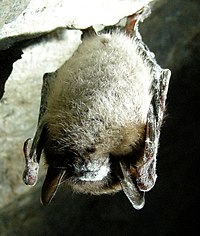
Back متلازمة الأنف الأبيض Arabic Sindrom bijelog nosa BS Syndrom bílého nosu Czech White-Nose-Syndrom German Síndrome de la nariz blanca Spanish Syndrome du nez blanc French תסמונת האף הלבן HE Zespół białego nosa Polish Синдром белого носа Russian White nose syndrome SIMPLE

White-nose syndrome (WNS) is a fungal disease in North American bats which has resulted in the dramatic decrease of the bat population in the United States and Canada, reportedly killing millions as of 2018.[1] The condition is named for a distinctive fungal growth around the muzzles and on the wings of hibernating bats. It was first identified from a February 2006 photo taken in a cave located in Schoharie County, New York.[2] The syndrome has rapidly spread since then. In early 2018, it was identified in 33 U.S. states and seven Canadian provinces; plus the fungus, albeit sans syndrome, had been found in three additional states.[3] Most cases are in the eastern half of both countries, but in March 2016, it was confirmed in a little brown bat in Washington state.[4] In 2019, evidence of the fungus was detected in California for the first time, although no affected bats were found.[5]
The disease is caused by the fungus Pseudogymnoascus destructans, which colonizes the bat's skin. No obvious treatment or means of preventing transmission is known,[6][7] and some species have declined by more than 90% within five years of the disease reaching a site.[8]
The US Fish and Wildlife Service (USFWS) has called for a moratorium on caving activities in affected areas[9] and strongly recommends to decontaminate clothing or equipment in such areas after each use. The National Speleological Society maintains an up-to-date page to keep cavers apprised of current events and advisories.[10]
- ^ "NUSGS report on white-nose syndrome". US Geological Survey. May 2018. Archived from the original on 2019-09-30. Retrieved 2018-07-07.
- ^ Blehert DS, Hicks AC, Behr M, Meteyer CU, Berlowski-Zier BM, Buckles EL, Coleman JT, Darling SR, Gargas A, Niver R, Okoniewski JC, Rudd RJ, Stone WB (January 2009). "Bat white-nose syndrome: an emerging fungal pathogen?" (PDF). Science. 323 (5911): 227. doi:10.1126/science.1163874. PMID 18974316. S2CID 23869393.
- ^ Whitenosesyndrome.org: "Where is WNS now" July 2018
- ^ Cite error: The named reference
:0was invoked but never defined (see the help page). - ^ DanaMichaels2013 (2019-07-05). "Deadly Bat Fungus Detected in California". CDFW News. Archived from the original on 2019-07-22. Retrieved 2019-07-22.
{{cite web}}: CS1 maint: numeric names: authors list (link) - ^ Coghlan A (26 October 2011). "Bat killer identified". New Scientist.
- ^ Ferrante J. "Bucknell University professor, national research team identify cause of White-Nose Syndrome in bats". Archived from the original on 2019-01-03. Retrieved 2012-04-06.
- ^ Langwig KE, Frick WF, Bried JT, Hicks AC, Kunz TH, Kilpatrick AM (September 2012). "Sociality, density-dependence and microclimates determine the persistence of populations suffering from a novel fungal disease, white-nose syndrome". Ecology Letters. 15 (9): 1050–7. doi:10.1111/j.1461-0248.2012.01829.x. PMID 22747672. S2CID 12803482.
- ^ "Cave activity discouraged to help protect bats from deadly white-nose syndrome" (PDF) (Advisory). US Fish and Wildlife Service. March 26, 2009.
- ^ "White Nose Syndrome Page". National Speleological Society. Retrieved 9 November 2011.